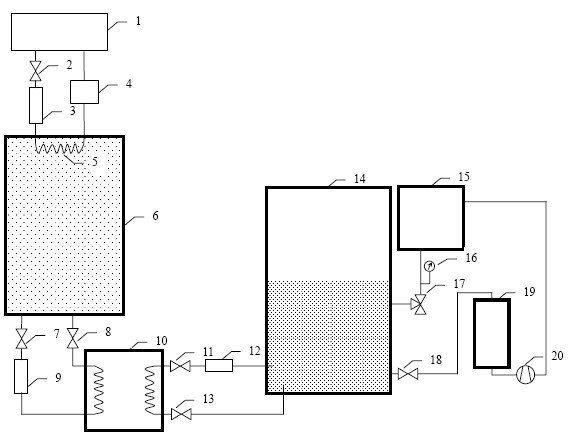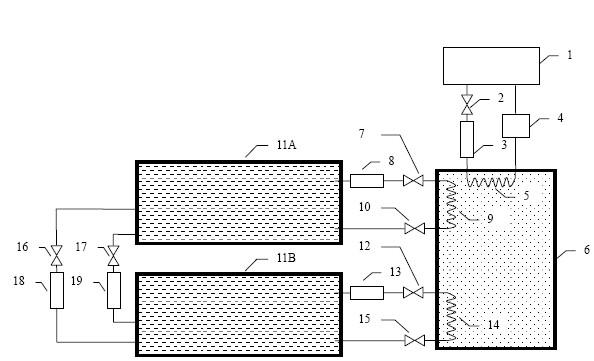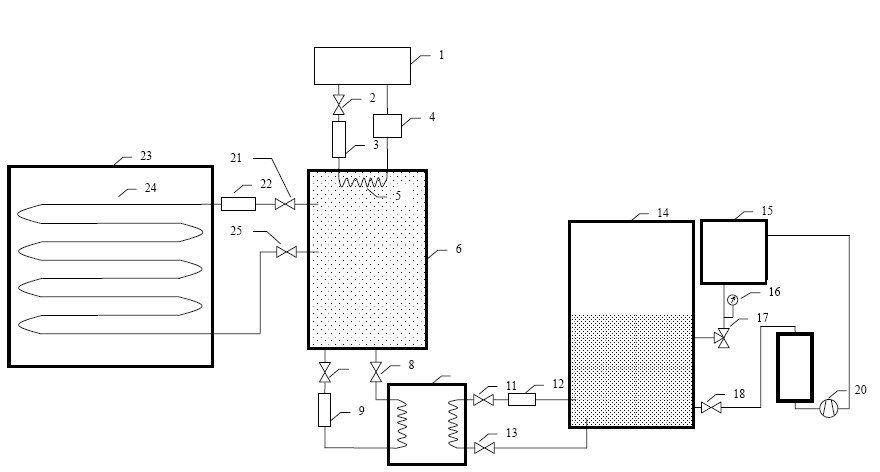Method and device for keeping fresh aquatic products by cold accumulation on board
A technology for aquatic products and cold storage, which is applied in household refrigeration devices, hull ventilation/heating/cooling, applications, etc. It can solve problems such as high energy consumption, high cost, and poor fresh-keeping quality, and achieve reduction in labor force, energy consumption, and The effect of waiting time
- Summary
- Abstract
- Description
- Claims
- Application Information
AI Technical Summary
Problems solved by technology
Method used
Image
Examples
Embodiment 1
[0032] A method for cold storage and preservation of aquatic products on board. In this method, the brine in the cold storage tank is maintained at a temperature of -30°C to -5°C through the ship's refrigeration system in advance, and then the seawater in the cooling water tank and the cold brine in the cold storage tank are separated. Indirect cold and heat exchange reduces the seawater temperature in the cooling water tank to 10°C to -10°C, and the caught fish can be cooled in the cold seawater tank to quickly cool the fish body to the central temperature of -5°C to 10°C After reaching the cooling requirement.
[0033] The cooled fish catch is taken out and stored in the on-board refrigerator, and the brine in the cold storage tank is connected with the on-board refrigerator through a heat exchanger, so that the temperature in the on-board refrigerator is maintained at -5°C to 15°C. The low-temperature cold storage tank can also be connected to the refrigerator or refrigerat...
Embodiment 2
[0036] refer to figure 1, a device for cold storage and preservation of aquatic products on board, which includes a cold storage tank 6, a cooling water tank 14, and a ship-mounted refrigeration system, and the ship-mounted refrigeration system includes a compressor 4, a condenser 1, an expansion valve 2 and an evaporator 5 , the expansion valve 2 and the compressor 4 are respectively connected to both ends of the evaporator 5, one end of the condenser 1 is connected to the compressor 4, the other end of the condenser 1 is connected to the expansion valve 2, and the The evaporator 5 is submerged in the cold storage tank 6 , and the cold storage tank 6 is connected to the cooling water tank 14 through an indirect heat exchanger.
[0037] In this embodiment, the first water outlet and the first water inlet of the cold storage tank 6 communicate with one end of the indirect heat exchanger 10, and a first Water pump 9, the other end of the indirect heat exchanger 10 communicates ...
Embodiment 3
[0046] Such as figure 1 As shown, the outlet of the compressor 4 is connected to the inlet of the condenser 1, and the medium in the condenser 1 is cooled by ammonia as the refrigerant, flows from the outlet to the expansion valve 2, and then passes through the dry filter 3 to the evaporator 5. The cold storage tank 6 is filled with brine containing 25% (w / w) sodium chloride, the evaporator 5 is immersed in the brine, and exchanges heat and cold with the brine, cools down the brine and keeps it at -18°C . The low-temperature cold brine is transported to the plate heat exchanger 10 through the water pump 9 to exchange heat and cold with the seawater in the cooling water tank 14 of the heat exchanger 10 through the water pump 12, and the temperature of the sea water in the cooling water tank 14 is lowered to 0° C. Cool sea water.
[0047] The 500kg sea prawns caught on board are put into net bags and put into the cooling water tank 14 for cooling. During the cooling period, th...
PUM
 Login to View More
Login to View More Abstract
Description
Claims
Application Information
 Login to View More
Login to View More - R&D
- Intellectual Property
- Life Sciences
- Materials
- Tech Scout
- Unparalleled Data Quality
- Higher Quality Content
- 60% Fewer Hallucinations
Browse by: Latest US Patents, China's latest patents, Technical Efficacy Thesaurus, Application Domain, Technology Topic, Popular Technical Reports.
© 2025 PatSnap. All rights reserved.Legal|Privacy policy|Modern Slavery Act Transparency Statement|Sitemap|About US| Contact US: help@patsnap.com



